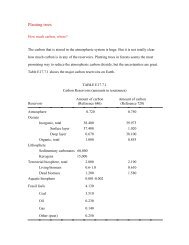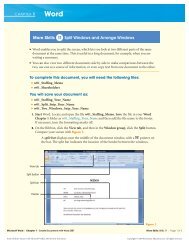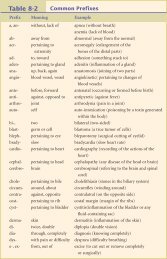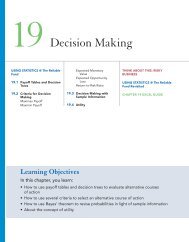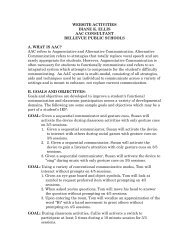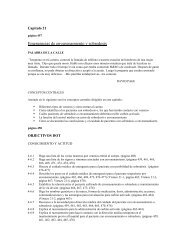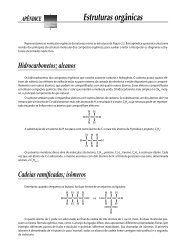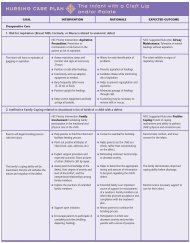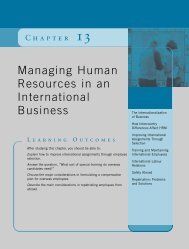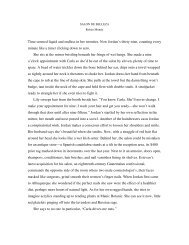928 NURSING CARE PLAN The Child or Adolescent Hospitalized ...
928 NURSING CARE PLAN The Child or Adolescent Hospitalized ...
928 NURSING CARE PLAN The Child or Adolescent Hospitalized ...
Create successful ePaper yourself
Turn your PDF publications into a flip-book with our unique Google optimized e-Paper software.
<strong>NURSING</strong> <strong>CARE</strong> <strong>PLAN</strong><br />
NIC Intervention: Socialization<br />
Enhancement: Facilitation of ability<br />
to interact with others.<br />
■ Assist the child <strong>or</strong> adolescent to<br />
identify topics and activities of<br />
interest.<br />
■ Encourage interaction with peers<br />
and staff.<br />
■ Facilitate visits from family and<br />
friends.<br />
■ Provide guidance to family<br />
regarding interaction that<br />
promotes self-esteem.<br />
NIC Intervention: Nutrition<br />
Management: Assistance with <strong>or</strong><br />
provision of a balanced dietary intake<br />
of foods and fluids.<br />
■ Offer nutritious finger foods,<br />
sandwiches, and high-cal<strong>or</strong>ie liquid<br />
supplements frequently throughout<br />
the day.<br />
■ Offer easy-to-carry drinks that are<br />
high in vitamins, minerals, and<br />
cal<strong>or</strong>ies.<br />
■ Encourage daily vig<strong>or</strong>ous physical<br />
activity of at least 30 minutes.<br />
<strong>The</strong> <strong>Child</strong> <strong>or</strong> <strong>Adolescent</strong> <strong>Hospitalized</strong><br />
with Depression (continued)<br />
GOAL INTERVENTION RATIONALE EXPECTED OUTCOME<br />
3. Impaired Social Interaction related to self concept disturbance<br />
<strong>The</strong> child <strong>or</strong> adolescent will participate<br />
in and initiate activities and<br />
conversation.<br />
■ <strong>The</strong> m<strong>or</strong>e the child <strong>or</strong> adolescent<br />
focuses on areas of interest, the less<br />
he <strong>or</strong> she will focus on internal<br />
anxiety and depression.<br />
■ Each positive interaction reinf<strong>or</strong>ces<br />
feelings of success. Each success<br />
reinf<strong>or</strong>ces the desire f<strong>or</strong> future<br />
social interaction.<br />
■ Reinf<strong>or</strong>ces positive and rewarding<br />
relationships.<br />
■ <strong>The</strong> family’s existing interaction<br />
style is often negative.<br />
4. Altered Nutrition: Less Than Body Requirements related to loss of appetite secondary to depression<br />
<strong>The</strong> child <strong>or</strong> adolescent’s daily intake<br />
will be adequate to maintain optimal<br />
nutritional status.<br />
■ Convenient easy-to-eat foods<br />
encourage the child <strong>or</strong> adolescent<br />
to eat and maintain nutritional<br />
status.<br />
■ <strong>The</strong>se are a convenient method f<strong>or</strong><br />
meeting hydration and electrolyte<br />
needs.<br />
■ Physical activity stimulates appetite.<br />
NOC Outcome: Social Interaction<br />
Skills: An individual’s use of effective<br />
interaction behavi<strong>or</strong>s.<br />
By discharge, the child <strong>or</strong> adolescent<br />
initiates conversation and activities<br />
with staff and peers.<br />
NOC Outcome: Nutritional Status:<br />
Amount of food and fluid taken into<br />
the body over a 24-hour period.<br />
<strong>The</strong> child <strong>or</strong> adolescent’s daily intake<br />
will be adequate to maintain optimal<br />
nutritional status by discharge.




